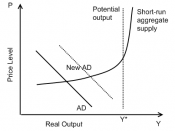The paper includes around 12 graphs comparing Japanese and Australian performance in various macroeconomic measures. However the text body itself has a lot of good analysis.
---------------------------------
Japanese economy got into a downwards trend with the stock market crash in 1989. Because of the decrease in aggregate demand, lack of private consumption and business investment due to deflation and over investment respectively, near future does not look very bright either.
This report is divided into four parts. The first part will briefly review the economic literature on Japan's economy during the success years till 1989; second part will make comparative analysis on economic development of Japan and Australia over the last 30 years; then we will look at the share price movements and exchange rate fluctuations finally we will look at the changing trade structure and its effect on food industry in Australia.
Japanese Economy From War till 1989
Post war Japanese economy was seen as one of the biggest economic successes in the economical history.
Double digit growth numbers of 1960s placed Japan as the second largest market economy after USA in 1968.
To shed light as to why Japan became such a success one must seek to understand socio-cultural aspects as well as prominent micro economic factors resulting in its post-war boom. The Japanese business system must be seen in conjunction with the "total structural and institutional mechanisms of the Japanese economy which have both shaped and enabled it to function effectively". Japanese idea was that the government would do a better job of managing national interests than the free market as in the Western world, although combined with a close relationship with the private sector. The government played an essential role by promoting communication between itself and the private sector, emphasising the importance of market performance where...


